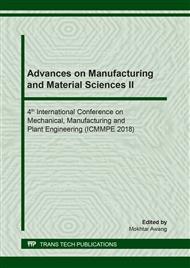[1]
Pourbaix, M., Applications of electrochemistry in corrosion science and in practice. Corrosion Science, 1974. 14: pp.25-82.
DOI: 10.1016/s0010-938x(74)80006-5
Google Scholar
[2]
U.S. Demand for Corrosion Inhibitors to Reach $2.5 Billion in 2017, in https://www.pfonline.com.
Google Scholar
[3]
Chetouani, A., B. Hanmouti, and M. Benkaddour, Corro- sion Inhibition of Iron in Hydrochloric Acid Solution by Jojoba Oil. Pigment and Resin Technology, 2004. 33(1): pp.26-31.
DOI: 10.1108/03699420410512077
Google Scholar
[4]
Dariva, C.G. and A.F. Galio, Corrosion Inhibitors – Principles, Mechanisms and Applications, in Developments in Corrosion Protection. 2014, IntechOpen. pp.265-279.
Google Scholar
[5]
Thaker, J. and J. Banerjee, Influence of intermittent flow sub-patterns on erosion-corrosion in horizontal pipe. Journal of Petroleum Science and Engineering, 2016. 145: pp.298-320.
DOI: 10.1016/j.petrol.2016.05.006
Google Scholar
[6]
Abdel-Gaber, A., B. Abd-El-Nabey, and M. Saadawy, The role of acid anion on the inhibition of the acidic corrosion of steel by lupine extract. Corrosion science, 2009. 51(5): pp.1038-1042.
DOI: 10.1016/j.corsci.2009.03.003
Google Scholar
[7]
Raja, P.B. and M.G. Sethuraman, Natural products as corrosion inhibitor for metals in corrosive media—A review. Materials Letters 2008. 62: p.113–116.
DOI: 10.1016/j.matlet.2007.04.079
Google Scholar
[8]
Buchweishaija, I. and G.S. Mhinzi, Natural products as a source of environmentally friendly corrosion inhibitors: The case of gum exudates from Acacia seyal var.Seyal. Portugaliae Electrochimica Acta, 2008. 26(3): pp.257-265.
DOI: 10.4152/pea.2008032257
Google Scholar
[9]
Odusote1, J.K. and O.M. Ajayi, Corrosion Inhibition of Mild Steel in Acidic Medium by Jathropha Curcas Leaves Extract. Journal of Electrochemical Science and Technology, 2013. 4(2): pp.81-87.
DOI: 10.5229/jecst.2013.4.2.81
Google Scholar
[10]
Kumar, K.P.V., M.S.N. Pillai, and G.R. Thusnavis, Inhibition of mild steel corrosion in hydrochloric acid by the seed husk extract of Jatropha curcas J. Mater. Environ. Sci. , 2010. 1(2): pp.119-128.
Google Scholar
[11]
Rani, P.D., M.Phil., and S. Selvaraj, Comparative Account of Jatropha curcas on Brass (Cu-40 Zn) in Acid and Sea Water Environment. The Pacific Journal of Science and Technology, 2011. 12(1): pp.38-49.
Google Scholar
[12]
J., O.S., et al., Jatropha Curcas Leaves Extract as Corrosion Inhibitor for Mild Steel in 1M Hydrochloric Acid. Journal of Emerging Trends in Engineering and Applied Sciences 2014. 4(1): pp.138-143.
Google Scholar
[13]
AJAYI, O.M., J.K. ODUSOTE, and R.A. YAHYA, Inhibition of mild steel corrosion using Jatropha Curcas leaf extract. J. Electrochem. Sci. Eng. , 2014. 4(2): pp.67-74.
DOI: 10.5599/jese.2014.0046
Google Scholar
[14]
Omotoyinbo, J.A., D.T. Oloruntoba, and S.J. Olusegun, Corrosion Inhibition of Pulverized Jatropha Curcas Leaves on Medium Carbon Steel in 0.5 M H2SO4 and NaCl Environments. International Journal of Science and Technology, 2013. 2(7).
Google Scholar
[15]
O., M., et al., Inhibition of Steel Corrosion in 1M HCl by Jatropha Curcas oil. J. Mater. Environ. Sci., 2014. 5(1): pp.310-319.
Google Scholar
[16]
Mohadyaldinn, M.E. and N.A.A.K. Azad, Evaluation of Jatropha Curcas Oil as Corrosion Inhibitor of CO2 Corrosion in Petroleum Production Environment. Journal of Applied Environmental and Biological Sciences, 2017: pp.28-34.
Google Scholar
[17]
Yousufi, M.M., M.E.M. Elhaj, and M. Moniruzzaman. Comparative Analysis of Corrosion Inhibition: Between Jatrophacurcas, Palm and Diesel Oil based Emulsified Acids for Acid Stimulation Operations. in 2nd International Conference on Energy and Environmental Science. 2018. Kuala lumpur: IOP Publishing.
DOI: 10.1088/1755-1315/164/1/012006
Google Scholar
[18]
O.Hamdani, M., Inhibition of steel corrosion in 1M HCl by Jatropha Curcas Oil. J.Master.Environ Sci, 2014. 5(1)(2028-2508).
Google Scholar


